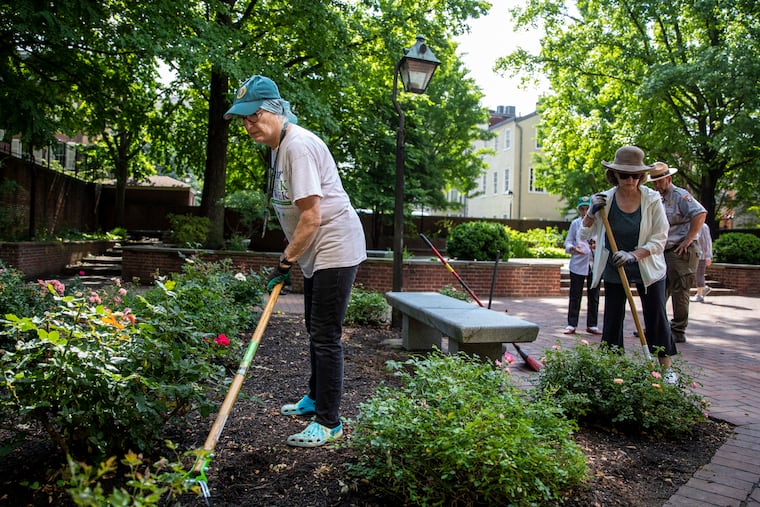Volunteers bring the bloom back to Independence Historical Park’s ‘secret gardens’
The gardeners are more needed than ever as pocket parks around Independence Hall have drawn more visitors during the pandemic.

Joan Wells and her husband, Dane, owned the Queen Victoria Bed & Breakfast in Cape May until they retired in 2004 and moved to Philadelphia.
But Joan Wells found she missed the gardening and began looking for a way to offer her skills. For the last seven years, she’s been part of a small group of dedicated volunteers who plant, weed, and help maintain several small historic parks, sometimes referred to as “secret gardens,” that dot the Independence National Historical Park system.
“It’s satisfying,” Wells said Wednesday morning as she helped coordinate volunteers at the Rose Garden, wedged between Fourth and Fifth Streets, bordered by Locust and Walnut, and donated to the National Park Service in 1971 by the Daughters of the American Revolution.
“It’s been particularly satisfying these last couple of years when we see how much appreciated the gardens are,” Wells said. “They’ve always been busy with dog walkers and sightseers, but now with so many wedding parties and nursery schools and other folks using them, it’s just wonderful.”
Many of the pocket parks, such as the Rose Garden, are tucked away, missed by some passersby, though they are open to the public.
The parks, however, have been rediscovered during the pandemic, becoming more important both because of that and the coming Semiquincentennial, or 250th anniversary, of the United States on July 4, 2026. On any given day, workers can be seen eating their lunches at the parks and school groups are enjoying them too.
Requests for wedding permits at the parks have increased by 50% since the pandemic, according to Andrew McDougall, an Independence Park spokesperson.
On Wednesday, Wells, 73, who lives at 15th and Spruce, rode her electric bike to the Rose Garden. There, she met Ruth DeCou, Ellen Lipschutz, and Susan Fryd. Despite the heat and humidity, they began weeding and picking deadheads off the dozens of rosebushes that give the park its name.
The roses peaked several weeks ago, but cutting off the browned blooms has allowed them to continue flowering. In 2018, The Inquirer chronicled how the Rose Garden had become choked with weeds.
Wells said there was a coordination issue that year that she’s helped straighten out, and the gardening is back on track. She credits “lots of other volunteers” and the National Park Service.
Wells first learned of the need for volunteers through Friends in the City, a group of seniors. She began volunteering so often that she’s assumed the role of unofficial coordinator.
Matthew Hess, chief of the park’s preservation and maintenance, calls the volunteers invaluable.
“The groundskeeping crew takes care of things like maintaining the turf, seasonal planting, spreading mulch, removing leaves in the spring and fall, and daily trash pickup,” Hess said. “But the park covers 55 acres, and there is a limit to how much time they can spend in one place. When members of the public donate their time and energy to activities like weeding, planting, and pruning, it really makes a difference.”
He noted the improvements to the Rose Garden, which will get a makeover for 2026.
“You can see the big change that’s happened, and that’s pretty much a direct result of the volunteers’ involvement,” Hess said.
Independence Park gets five million visitors in a typical year. That doesn’t include thousands of local residents who spend time in places like the Rose Garden.
Jen Sharp, an early childhood teacher at a Germantown Friends School Center City campus, brought a group of students to the park Wednesday, something she does regularly.
“It’s become our outdoor space,” Sharp said. “All of these are city kids, and it gives them a sense of the parks and the stewardship needed to care for them. The volunteers are amazing. They are out here all the time. They help maintain these parks and it’s why we can come out here and enjoy them.”
Besides the Rose Garden, the volunteers also help maintain:
The 18th Century Garden just above Walnut Street between Third and Fourth Streets, which is marked by a gazebo, trellis, and neatly squared gardens of boxwoods, begonias, hollies, and other perennials meant to replicate a typical park of that era.
The Magnolia Garden, between Fourth and Fifth off Locust, just south of the Rose Garden, which was donated in 1959 by the Garden Club of America and has a fountain as its centerpiece.
The Bishop White Garden, often referred to as the Rush Garden, at Third and Walnut, is at the site of the home of Benjamin Rush, considered a founding father, and is also an 18th-century garden with beds rimmed by boxwoods.
Carpenters Hall at Third and Chestnut, which hosted the First Continental Congress in 1774 and other historic organizations and events, is bordered by a small garden.
Pemberton House, also at Third and Chestnut, a reconstructed Georgian mansion once owned by a Quaker merchant and now the bookstore for Independence National Historical Park, has a small garden.
The Edgar Allan Poe House, 532 N. Seventh St., which Poe rented, has a pollinator garden recently installed by DeCou and the Daughters of the American Revolution. Poe crafted some of his best-known works when he lived in Philadelphia, including “The Tell-Tale Heart” and “The Murders in the Rue Morgue.”
Wells is originally from Montana but has come to love Philadelphia. She also volunteers at the Schuylkill River Park.
“Sometimes there are just two of us. Sometimes there are six or eight,” Wells said. “But I think we’ve just made such a transformation.”